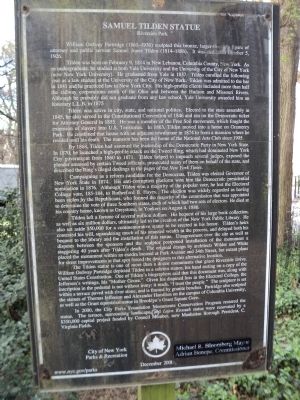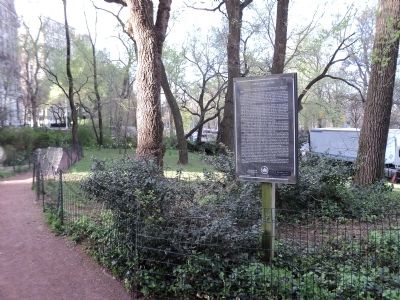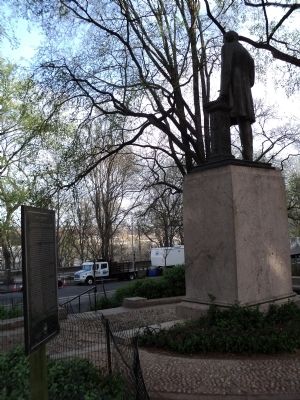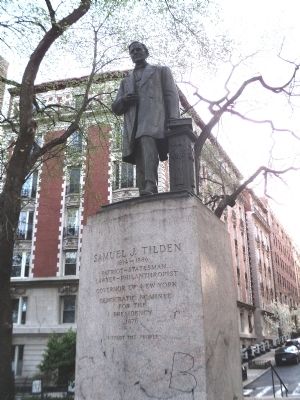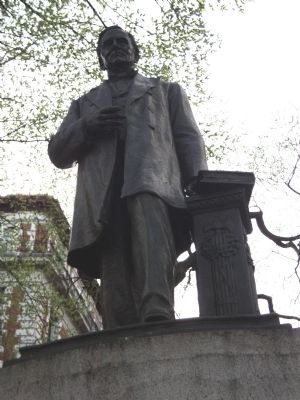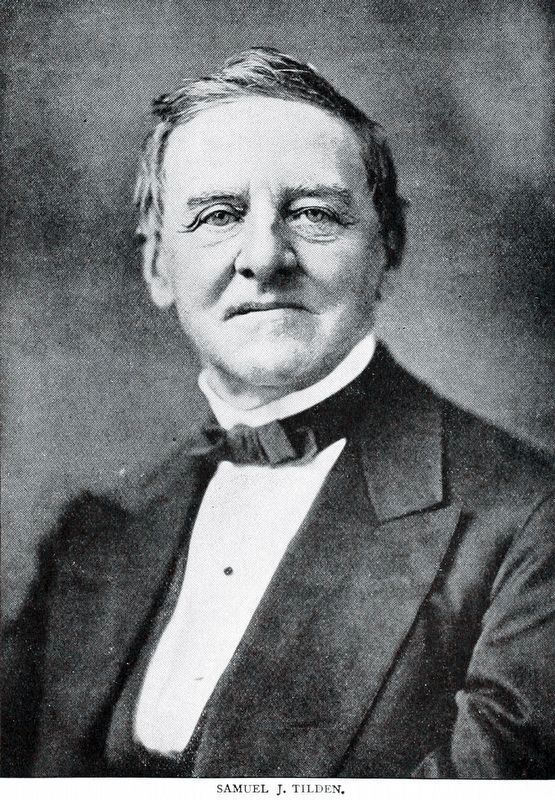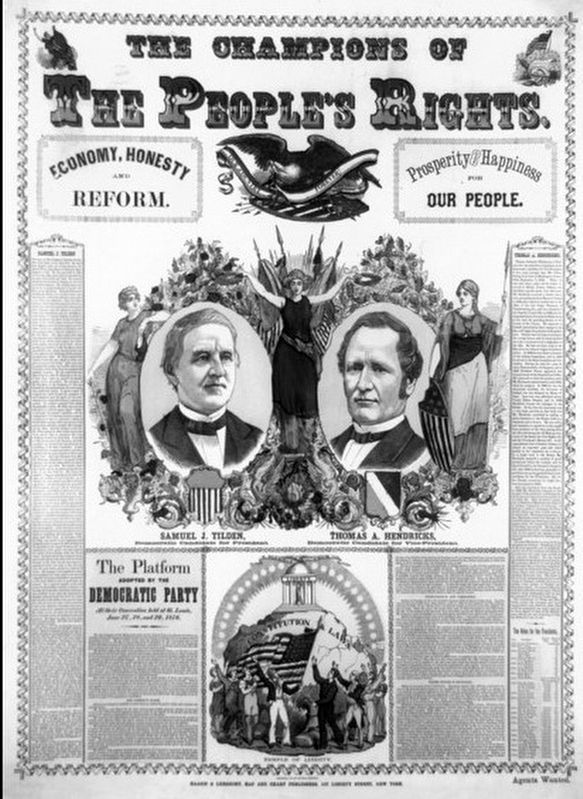Morningside Heights in Manhattan in New York County, New York — The American Northeast (Mid-Atlantic)
Samuel Tilden Statue
Riverside Park
William Ordway Partridge (1861-1930) sculpted this bronze, larger-than-life figure of attorney and public servant Samuel Jones Tilden (1814-1886). It was dedicated October 5, 1926.
Tilden was born on February 9, 1814 in New Lebanon, Columbia County, New York. As an undergraduate, he studied at both Yale University and the University of the City of New York (now New York University). He graduated from Yale in 1837. Tilden enrolled the following year as a law student at the University of the City of New York. Tilden was admitted to the bar in 1841 and he practiced law in New York City. His high-profile clients included more than half the railway corporations north of the Ohio and between the Hudson and Missouri Rivers. Although he probably did not graduate from any law school, Yale University awarded him an honorary L.L.B. in 1875.
Tilden was active in city, state, and national politics. Elected to the state assembly in 1845, he also served in the Constitutional Convention of 1846 and ran on the Democratic ticket for Attorney General in 1855. He was a member of the Free Soil movement, which fought the extension of slavery into U.S. Territories. In 1863, Tilden moved into a home on Gramercy Park. He combined that house with an adjacent townhouse in 1874 to form a mansion where he resided until his death. The mansion has been the home of the National Arts Club since 1905.
By 1868, Tilden had assumed the leadership of the Democratic Party in New York State. In 1870, he launched a high-profile attack on the Tweed Ring, which had dominated New York City government from 1860 to 1871. Tilden helped to impeach several judges, exposed the plunder amassed by certain Tweed officials, prosecuted many of them on behalf of the state, and described the Ring’s illegal dealings in the pages of the New York Times.
Campaigning as a reform candidate for the Democrats, Tilden was elected Governor of New York State in 1874. His anti-corruption platform won him the Democratic presidential nomination in 1876. Although Tilden won a majority of the popular vote, he lost the Electoral College vote, 185-184, to Rutherford B. Hayes. The election is widely regarded as having been stolen by the Republicans, who formed a majority of the commission that was appointed to determine the vote of three Southern states, each of which had two sets of electors. He died at his country home, known as Greystone, in Yonkers on August 4, 1886.
Tilden left a fortune of several million dollars. His bequest of his large book collection, as well as six million dollars, ultimately led to the creation of the New York Public Library. He also set aside $50,000 for a commemorative statue to be erected in his honor. Tilden’s heirs contested his will, squandering much of his amassed wealth in the process, and delayed both his bequest to the library and the installation of this statue. Disagreement over the site as well as disputes between the sponsors and the sculptor postponed installation of the monument a staggering 40 years after Tilden’s death. The original design by architects Wilder and White placed the monument within an exedra located at Park Avenue and 34th Street, but extant plans for street improvements at that spot forced the designers to this alternate location.
The Tilden statue is one of more than a dozen monuments that grace Riverside Drive. William Ordway Partridge depicted Tilden in a solemn stance, his hand resting on a copy of the United States Constitution. One of Tilden’s biographers said that this document was, along with Jefferson’s writings, his “Mother Goose.” Given his disputed loss in the Electoral College, the inscription in the pedestal is not without irony: it reads, “I trust the people.” The sculpture is set within a terrace paved with river stone, and is framed by granite benches. Partridge also sculpted the statues of Thomas Jefferson and Alexander Hamilton on the campus of Columbia University, as well as the Grant equestrian statue in Brooklyn’s Grant Square Gore.
In 2000, the
City Parks Foundation Monuments Conservation Program restored the statue. The terrace, surrounding landscape, and Lajos Kossuth statue were renovated by a $350,000 capital project funded by Council Member, now Manhattan Borough President, C. Virginia Fileds.
City of New York Parks & Recreation
Michael R. Bloomberg, Mayor
Adrian Benepe, Commissioner
December 2001
Erected 2001 by City of New York Parks & Recreation.
Topics. This historical marker is listed in these topic lists: Arts, Letters, Music • Charity & Public Work • Education. A significant historical month for this entry is February 1788.
Location. 40° 48.368′ N, 73° 58.048′ W. Marker is in Manhattan, New York, in New York County. It is in Morningside Heights. Marker is at the intersection of Riverside Drive and W 112th Street, on the left when traveling north on Riverside Drive. Touch for map. Marker is in this post office area: New York NY 10025, United States of America. Touch for directions.
Other nearby markers. At least 8 other markers are within walking distance of this marker. Samuel J. Tilden (here, next to this marker); Kossuth (within shouting distance of this marker); Lajos Kossuth Monument (within shouting distance of this marker); Morningside Heights Historic District (about 400 feet away, measured in a direct line); Cecil B. DeMille (about 500 feet away); John Dewey (about 700 feet away); Hannah Arendt (about 700 feet away); Harlan Fiske Stone (approx. 0.2 miles away). Touch for a list and map of all markers in Manhattan.
Credits. This page was last revised on January 31, 2023. It was originally submitted on March 29, 2012, by Bill Coughlin of Woodland Park, New Jersey. This page has been viewed 599 times since then and 30 times this year. Photos: 1, 2, 3, 4, 5. submitted on March 29, 2012, by Bill Coughlin of Woodland Park, New Jersey. 6. submitted on February 21, 2019, by Allen C. Browne of Silver Spring, Maryland. 7. submitted on April 12, 2020, by Larry Gertner of New York, New York.
